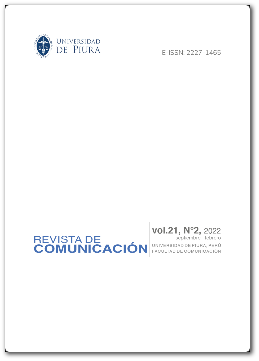Descubriendo Netflix: identidad de marca y representaciones de la diversidad
DOI:
https://doi.org/10.26441/RC21.2-2022-A9Palabras clave:
Netflix, industria audiovisual, diversidad, identidad de marca, culturaResumen
Este artículo analiza la identificación estratégica de Netflix con la noción de diversidad, tanto fuera (off-screen) como dentro de la pantalla (on-screen). A partir de su comunicación pública, de informes sectoriales y de la literatura sobre el tema, se centra en examinar dos dimensiones: la relación entre diversidad, inclusión, política de empresa e identidad de marca Netflix, incidiendo en la diversidad de la fuerza laboral (off-screen); y la diversidad de sus contenidos a partir de la amplia categoría de Netflix Originals, considerando la diversidad de lugar, género y etnicidad o “raza” (on-screen). De este modo, el texto revela críticamente múltiples estrategias complementarias, empleadas crecientemente a nivel global para construir una identidad de marca vinculada a la diversidad en tanto valor positivo, reivindicado en el siglo XXI. Mediante esta identificación de marca con la diversidad, Netflix busca distinguirse tanto de la industria audiovisual tradicional como de sus competidores, lo cual contribuye a su hegemonía en el mercado global de vídeo bajo demanda.
Métricas
Citas
Afilipoaie, A.; Iordache, C.; y Raats, T. (2021). The ‘Netflix Original’ and what it means for the production of European television content. Critical Studies in Television: The International Journal of Television Studies, 16(3), 304-325.
https://doi.org/10.1177/17496020211023318. DOI: https://doi.org/10.1177/17496020211023318
Albornoz, L. A. y García Leiva, Mª T. (Eds.) (2017). Diversidad e industria audiovisual. El desafío cultural del siglo XXI. Fondo de Cultura Económica.
Albornoz, L. A. y García Leiva, Mª. T. (Eds.) (2019). Audiovisual Industries and Diversity. Economics and Policies in the Digital Era. Routledge. DOI: https://doi.org/10.4324/9780429427534
Albornoz, L. A. y García Leiva, Mª. T. (2021). Netflix Originals in Spain: challenging diversity. European Journal of Communication, 1-19. https://doi.org/10.1177/02673231211012174. DOI: https://doi.org/10.1177/02673231211012174
Aliende Urtasun, A. y Azcona Mauleón, J. (2007). Identidad en A. Barañano, J. L. García, M. Cátedra y M. J. Devillard (Eds.), Diccionario de relaciones interculturales. Diversidad y globalización (pp. 183-184). Editorial Complutense.
Alonso, L. E. (2002). ¿Un nuevo consumidor?. Ábaco, 2(31), 11-18.
Anderson, T. (24 de junio de 2018). Everything you need to know about that Netflix ‘Strong Black Lead’ spot you saw during the BET Awards. Los Angeles Times. https://lat.ms/3agh7t3.
Asmar, A. (2021). Branding diversity. On the corporate and cultural strategy at the heart of Netflix’s expansion. Symposium A decade of Netflix in Europe: Lessons from a small media market. https://bit.ly/31MMae8.
Augé, M. (2000). Los no lugares. Espacios del anonimato. Gedisa.
Banet-Weiser, S. (2012). Authentic: The Politics of Ambivalence in a Brand Culture. NYU Press.
Bogle, D. (2016). Toms, Coons, Mulattoes, Mammies, and Bucks. An interpretive history of blacks in American films. Bloomsbury.
Bourdieu, P. (1998). La distinción. Criterios y bases sociales del gusto. Taurus.
Cabrera Blázquez, F. J.; Cappello, M.; Talavera Milla, J.; y Valais, S. (2021). Diversity and inclusión in the European audiovisual sector. IRIS Plus 2021-1, European Audiovisual Observatory. https://bit.ly/3O7u3CS.
Carastathis, A. (2014). The Concept of Intersectionality in Feminist Theory. Philosophy Compass, 9(5), 304-314. https://doi.org/10.1111/phc3.12129. DOI: https://doi.org/10.1111/phc3.12129
Castañares, W. (2006). La televisión moralista. Valores y sentimientos del discurso televisivo. Editorial Fragua.
Clough, P. T. (2007). The Affective Turn. Theorizing the Social. Duke University Press. DOI: https://doi.org/10.2307/j.ctv11316pw
Consell de l’Audiovisual de Catalunya (18 de mayo de 2020). Presència i prominència d’obres europees a Netflix. Informe 82/2020. https://bit.ly/3OjVubT.
Costa, J. (2013). Los 5 pilares del branding. Anatomía de la marca. CPC Editor.
Crenshaw, K. W. (1991). Mapping the Margins: Intersectionality, Identity Politics, and Violence against Women of Color. Stanford Law Review, 43(6), 1241-1299. https://doi.org/10.2307/1229039. DOI: https://doi.org/10.2307/1229039
Da Silveira, C.; Lages, C. y Simões, C. (2013). Reconceptualizing brand identity in a dynamic environment. Journal of Business Research, 66, 28-36. https://doi.org/10.1016/j.jbusres.2011.07.020. DOI: https://doi.org/10.1016/j.jbusres.2011.07.020
Élite Netflix (30 de noviembre de 2018). Mina El Hammani y Saufeeya Goodson: una conversación a fondo. YouTube. https://bit.ly/3ofgZjn.
Farr, B. (2016). Seeing Blackness in Prison: Understanding Prison Diversity on Netflix’s Orange Is the New Black en K. McDonald y D. Smith-Rowsey (Eds.), The Netflix Effect. Technology and Entertainment in the 21st Century (pp. 155-169). Bloomsbury.
García, A. N. (Ed.) (2016). Emotions in Contemporary TV Series. Palgrave Macmillan. DOI: https://doi.org/10.1007/978-1-137-56885-4
Gauthier, P. (2019). Nostalgia as a Problematic Cultural Space: The Example of the Original Netflix Series GLOW (2017) en K. Pallister (Ed.), Netflix Nostalgia. Streaming the Past on Demand (pp. 75-90). Lexington Books.
Goffman, Erving (1993). La presentación de la persona en la vida cotidiana. Amorrortu.
Hall, S. (1992). What is ‘Black’ in Black Popular Culture en G. Dent (Ed.), Black Popular Culture (pp. 21-33). Bay Press.
Hastings, R. y McCord, P. (2009). Netflix Culture: Freedom & Responsability. https://bit.ly/3oDQzpU.
Hastings, R. y Meyer, E. (2020). Aquí no hay reglas. Netflix y la cultura de la reinvención. Conecta.
Jones, T. W. (1 de junio de 2018). Finding My PRIDE @ Netflix. Netflix website. https://jobs.netflix.com/blog/finding-my-pride-at-netflix.
Lipsitz, G. (2001). Time Passages. Collective Memory and American Popular Culture. University of Minnesota Press.
Live Nation (2019). Netflix X DCODE. https://bit.ly/3od8KEw.
Lobato, R. (2019). Netflix Nations. The Geography of Digital Distribution. NYU Press. DOI: https://doi.org/10.18574/nyu/9781479882281.001.0001
Lotz, A. D. (2014). The Television Will Be Revolutionized. NYU Press.
Lozano, J., Peñamarín, C. y Abril, G. (1999). Análisis del discurso. Hacia una semiótica de la interacción textual. Cátedra.
Madrigal, A. (2 de enero de 2014). How Netflix Reverse-Engineered Hollywood. The Atlantic. https://bit.ly/2Kg4p2V.
Mbomío Rubio, L. A. (2019). Hija del camino. Grijalbo.
McCord, P. (2014). How Netflix Reinvented HR. Harvard Business Review, enero-febrero. https://hbr.org/2014/01/how-netflix-reinvented-hr.
McCord, P. (2019). Ocho lecciones sobre cómo construir una empresa donde la gente disfrute trabajar. TED.com. https://bit.ly/3ozRbfT.
McDonald, K. y Smith-Rowsey, D. (2016). The Netflix Effect: Technology and Entertainment in the 21st Century. Bloomsbury.
Mohanpersad, A. (7 de mayo de 2019). Being Multicultural at Netflix. Netflix website. https://jobs.netflix.com/blog/being-multicultural-at-netflix.
Moon, Dreama G. y Holling, Michelle A. (Eds.) (2016). Race(ing) Intercultural Communication. Racial logics in a colorblind era. Routledge. DOI: https://doi.org/10.4324/9781315686158
Moore, A. (2002). Authenticity as authentication. Popular Music, 21(2), 209-223. DOI: https://doi.org/10.1017/S0261143002002131
Napoli, P. (1999). Deconstructing the Diversity Principle. Journal of Communication, 49(4), 7-34. DOI: https://doi.org/10.1111/j.1460-2466.1999.tb02815.x
Neira, E. (2020). Streaming wars. La nueva televisión. Libros Cúpula.
Netflix (s.f.a). ¿Dónde está disponible Netflix?. https://bit.ly/2WiHmXR.
Netflix (s.f.b). La cultura de Netflix. https://bit.ly/3p0wVnU.
Netflix (s.f.c). Inclusion & Diversity. https://jobs.netflix.com/inclusion.
Netflix (13 de junio de 2018). First Time I Saw Me: Trans Voices | Jazz Jennings | Netflix + GLAAD. YouTube. https://bit.ly/2WnbDVr.
Netflix (2020). Environmental Social Governance. 2019 Sustainibility Accounting Standards Board (SASB) Report. https://bit.ly/3riyoYD.
Netflix España (24 de marzo de 2020). Una mexicana en Madrid con Danna Paola. YouTube. https://bit.ly/3yV20Qy.
Netflix (13 de enero de 2021a). Inclusion Takes Root at Netflix: Our First Report. https://bit.ly/3GoU4Jt.
Netflix (22 de abril de 2021b). Un nuevo capítulo en la aventura de Netflix. https://bit.ly/39Kl4Zm.
Netflix (30 de marzo de 2022). Environmental Social Governance Report 2021.
Parrot Analytics (2020). The Global Television Demand Report.
Parrot Analytics (2021a). The Global Television Demand Report. Q1 Report.
Parrot Analytics (2021b). The Global Television Demand Report. Q2 Report.
Parrot Analytics (2021c). Battle Studies. News from the Frontlines of the Streaming Wars in Europe.
Pedro, J. (2022). Estrategias publicitarias de Netflix: publicidad exterior y presencia en el mercado español en B. Cantalapiedra Nieto, E. Ortega Fernández; y M. Blanco Pérez (Eds.), Comunicación, pantallas y ficción. Thomson Reuters-Aranzadi.
Radish, C. (7 de julio de 2013). Creator Jenji Kohan Talks Orange Is the New Black, Her Research Into Prison Life, and Graphic Sex Scenes. Collider. https://bit.ly/3pe2A5I.
Rainey, J. y Gray, T. (26 de enero de 2016). Diversity in Hollywood: Failure of Inclusion Plagues the Entire Industry. Variety. https://bit.ly/3ri0wew.
Redacción AV451 (4 de julio de 2022). Susana Casares desgrana Grow Creative, la iniciativa de Netflix en favor de la diversidad y la inclusión en el sector audiovisual. Audiovisual 451. https://bit.ly/3cvWlJq.
Rodríguez, R. y Mora, K. (2022). Frankenstein y el cirujano plástico. Una guía multimedia de semiótica de la publicidad. Universidad de Alicante.
Sandberg, B. y Goldberg, L. (22 de junio de 2018). Netflix Fires PR Chief After Use of N-Word in Meeting (Exclusive). The Hollywood Reporter. https://bit.ly/37Bz8jM.
Schwartz, B. (2003). The Paradox of Choice: Why More Is Less. Harper Collins.
Shontell, A. (4 de febrero de 2013). Sheryl Sandberg: ‘The Most Important Document Ever To Come Out Of The Valley’. Business Insider. https://bit.ly/2KEuBUS.
Still Watching Netflix (25 de junio de 2018). A Great Day in Hollywood. YouTube. https://bit.ly/3no4NLi.
VCU Brandcenter (8 de marzo de 2019). Netflix: “Make Room”. YouTube. https://bit.ly/3og2A6t.
Vlessing, E. (29 de agosto de 2018). Netflix Hires Verna Myers as Head of “Inclusion Strategy”. The Hollywood Reporter. https://bit.ly/2Jc0oMC.
Stoll, J. (20 de julio de 2022). Netflix subscribers count worldwide 2013-2022. Statista. https://bit.ly/3gR09Tm.
Wayne, M. L. (2018). Netflix, Amazon, and branded television content in subscription video on-demand portals. Media, Culture & Society, 40(5), 1-17. DOI: https://doi.org/10.1177/0163443717736118
WeAreNetflix (23 de abril de 2019). Netflix Culture: Brené Brown and Vernā Myers Discuss Inclusion and Diversity [Pódcast]. YouTube. https://bit.ly/3xJ4von.
WeAreNetflix (14 de julio de 2020). A Conversation with Netflix’s Employee Resource Groups. YouTube. https://bit.ly/3mlXMJu.
Publicado
Cómo citar
Número
Sección
Licencia
Derechos de autor 2022 Revista de Comunicación

Esta obra está bajo una licencia internacional Creative Commons Atribución-NoComercial-SinDerivadas 4.0.











 Portal de Revistas de la Universidad de Piura.
Portal de Revistas de la Universidad de Piura.